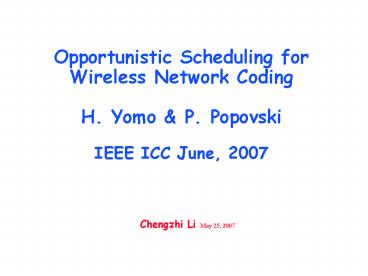Opportunistic Scheduling for Wireless Network Coding H' Yomo - PowerPoint PPT Presentation
1 / 12
Title:
Opportunistic Scheduling for Wireless Network Coding H' Yomo
Description:
Most existing results exploit the broadcast nature of ... Dynamically choose kop according to time-varying SNRs of N receiving nodes. Experimental Results ... – PowerPoint PPT presentation
Number of Views:203
Avg rating:3.0/5.0
Title: Opportunistic Scheduling for Wireless Network Coding H' Yomo
1
Opportunistic Scheduling for Wireless Network
CodingH. Yomo P. Popovski IEEE ICC June,
2007
- Chengzhi Li May 25, 2007
2
Outline
- Background Motivation
- System Model Basic Assumptions
- Adaptive rate and Opportunistic Scheduling with
Network Coding - Numeric Results
- Several Comments
3
Background Motivation
- Network coding has been extended to wireless
networks - e.g., XORs in the air practical wireless
network coding by S. Katti, et. al. Sigcomm
2006 - Most existing results exploit the
broadcast nature
of wireless
communications, but ignore the
corresponding feature
heterogeneous
and unreliable wireless channels - Motivation
- exploit network coding gain
in more
realistic wireless network
environment
4
Main Contribution
- Propose an opportunistic scheduling for network
coding to increase the throughput of wireless
networks in more realistic environments - First paper investigates the possible
transmission rate adaptation and opportunistic
scheduling for network coding
5
System Model
- Only considers a network
coding group - One relay node and N receiving nodes
- Relay node has the packets to
forward to all receiving nodes - Each receiving node has the packets
that will be forwarded to
other N-1
receiving nodes - Constant transmission power
- Wireless channels
- stationary
- slow fading
- white Gaussian noise
- rn(t) instantaneous SNR
at time t for node n,
1lt n lt N - are i.i.d. random variables
- follow Rayleigh distribution
- available at relay node
- Node n can successfully decode the transmitted
packet only if - transmission rate lt Blog2(1 rn) for frequency
bandwidth B
6
Rate Adaptation and Opportunistic Scheduling with
Network Coding
- Re-order rn(t), 1lt n lt N,
- Given k, relay node opportunistically select
N-k1 nodes with and XOR their
packets and broadcast at the rate - Instantaneous capacity
- Average capacity
- Two special cases
- k 1 classical wireless network coding
- k N classical opportunistic scheduling for
cellular networks - Opportunistic scheduling for wireless network
coding - Dynamically choose kop according to time-varying
SNRs of N receiving nodes
7
Experimental Results
- For opportunistic scheduling
- Only simulation results
- For fixed k scheduling
- Theoretical and simulation results
- The authors claim
- For fixed k scheduling, the theoretical results
closely match the simulation results
8
(No Transcript)
9
(No Transcript)
10
(No Transcript)
11
Final Remarks
- Is it worth to study wireless network coding in
more realistic environment by taking into account
about - Channel fading in door and out door
- Narrowband and wideband
- Packet error rate
- Wireless networks based on standards s.t. IEEE
802.11
12
Questions ?
Thanks You!































